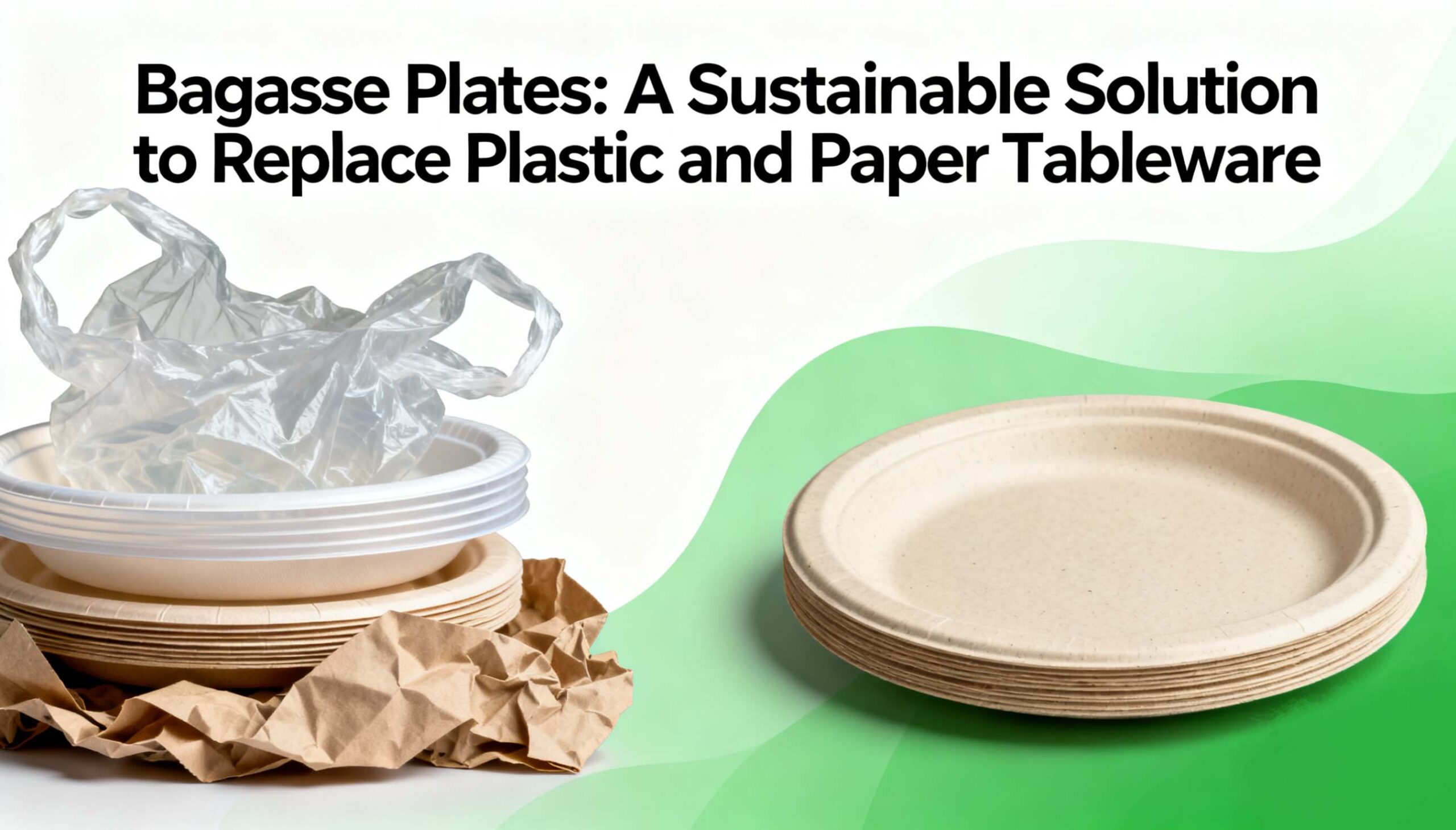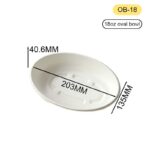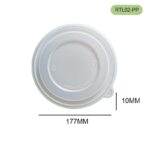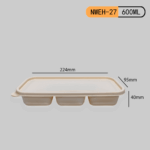Quick Summary
Bagasse plates, produced from sugarcane byproducts, are a sustainable alternative to plastic and PFAS-coated paper plates. Fully biodegradable and compostable, they combine strength, heat resistance, and versatility, making them suitable for both hot and cold foods. By utilizing agricultural waste, they reduce landfill burden and carbon emissions, positioning bagasse plates as an ideal eco-friendly choice for households, restaurants, and the foodservice industry.
Introduction: The Search for Sustainable Alternatives
In today’s world, the pressure to eliminate single-use plastics has intensified. Conventional disposable plates—whether plastic or coated paper—offer convenience but contribute heavily to pollution and long-term environmental damage. Plastics persist for centuries, while many paper plates rely on chemical coatings such as PFAS (per- and polyfluoroalkyl substances) to achieve water and oil resistance, raising health concerns.
Against this backdrop, bagasse plates have emerged as a practical, safe, and sustainable alternative. Made from the fibrous residue left after extracting juice from sugarcane, bagasse plates transform agricultural waste into a durable, compostable product that addresses both waste management and food packaging challenges.
What Are Bagasse Plates?
Bagasse is the dry, fibrous material remaining after sugarcane stalks are crushed to extract their juice. Traditionally, this material was treated as waste or burned for fuel. However, with advances in manufacturing, bagasse is now molded into plates, bowls, and trays that can replace plastic and chemically coated tableware.
Key features of bagasse plates include:
-
Biodegradability – They naturally decompose within 90–180 days in composting environments.
-
Compostability – Certified products can be disposed of in home or industrial compost systems, returning nutrients to the soil.
-
Strength & Durability – Despite being plant-based, bagasse plates are sturdy and resistant to bending or collapsing.
-
Heat & Grease Resistance – They can safely hold hot meals, soups, or oily foods without requiring harmful chemical coatings.
Environmental Advantages of Bagasse Plates
The environmental benefits of bagasse plates go beyond simple compostability.
-
Reducing Agricultural Waste
Instead of burning bagasse—which contributes to carbon emissions—manufacturers repurpose it into useful products, reducing overall waste. -
Minimizing Plastic Pollution
By replacing plastic plates, bagasse reduces the volume of non-biodegradable waste entering landfills and oceans. -
Eliminating Toxic Chemicals (PFAS-Free)
Many paper plates achieve grease resistance by adding PFAS, also known as “forever chemicals.” Bagasse products, however, achieve natural resistance without these harmful substances, making them safer for human health and the environment. -
Lower Carbon Footprint
Bagasse-based production uses renewable agricultural byproducts, avoiding the extraction of virgin fossil fuels required for plastics.
Performance Benefits Compared to Plastic and Paper Plates
Consumers often assume that eco-friendly products compromise on functionality, but bagasse plates perform on par—or better—than traditional alternatives.
-
Withstand High Temperatures: Bagasse plates can handle hot food and microwaving without warping.
-
Resist Oil and Moisture: Unlike uncoated paper, bagasse naturally resists liquids, making it suitable for curries, salads, and fried foods.
-
Strong and Rigid: They can support full meals without collapsing, unlike thin plastic or paper plates.
-
Freezer and Microwave Safe: Bagasse plates are suitable for both cold storage and reheating.
Health and Safety: Why PFAS-Free Matters
A major concern in disposable tableware is the use of PFAS coatings, which are added to paper plates for oil and water resistance. These chemicals do not break down in the environment and can accumulate in the human body, raising risks of cancer, hormone disruption, and immune system issues.
Bagasse plates stand out because they are naturally grease-resistant without requiring PFAS coatings. Choosing PFAS-free packaging protects not only the planet but also consumers’ health.
Applications of Bagasse Plates
Bagasse plates are versatile and suitable for multiple settings:
-
Households: Ideal for eco-conscious families seeking safe, compostable tableware.
-
Restaurants & Cafés: Perfect for dine-in or takeaway meals.
-
Catering & Events: Offer a sustainable solution for large gatherings, weddings, and parties.
-
Food Delivery & Supermarkets: Trusted for packaging hot, greasy, or liquid foods.
Certifications and Standards
To ensure safety and compliance, many bagasse plates carry internationally recognized certifications such as:
-
FDA 21CFR – U.S. food-contact safety standards
-
EU 10/2011 – Compliance for European markets
-
SGS Testing – Independent quality and safety validation
-
TÜV OK Compost HOME & INDUSTRIAL – Compostability certifications
-
ISO Standards – International benchmarks for quality and safety
These certifications guarantee that bagasse plates are free from harmful chemicals, safe for food contact, and compostable under proper conditions.
Market Trends and Consumer Demand

Global demand for sustainable packaging is accelerating. Governments are enacting bans on single-use plastics, supermarkets are phasing out plastic containers, and eco-conscious consumers are actively seeking biodegradable alternatives. Bagasse plates align perfectly with this trend by combining sustainability, functionality, and affordability.
Reports indicate that the global market for bagasse tableware is growing rapidly, driven by bans on PFAS-containing food packaging and rising awareness of environmental impacts.
Challenges and Future Outlook
While bagasse plates present clear advantages, there are still challenges:
-
Cost: Currently more expensive than low-grade plastics, though prices are decreasing as production scales.
-
Composting Infrastructure: Not all regions have composting facilities, limiting end-of-life benefits.
-
Consumer Awareness: Some consumers remain unaware of PFAS risks or bagasse alternatives.
Despite these challenges, industry momentum is strong. With stricter regulations, improved composting systems, and greater consumer education, bagasse plates are expected to become the mainstream solution for disposable tableware.
Conclusion
Bagasse plates represent more than just an eco-friendly option—they are a comprehensive solution to the global plastic and PFAS problem. By turning agricultural waste into functional, compostable products, they reduce landfill burden, eliminate toxic coatings, and offer consumers a healthier, more sustainable choice.
As the shift away from plastic accelerates, bagasse plates stand at the forefront of innovation, proving that sustainability and performance can coexist. Choosing bagasse isn’t just a purchase decision—it’s a step towards a cleaner, safer, and more responsible future.
FAQ – Bagasse Plates
1. What are bagasse plates?
Bagasse plates are eco-friendly disposable tableware made from sugarcane pulp, a fibrous byproduct of sugarcane juice extraction. They are biodegradable, compostable, and naturally grease-resistant without harmful chemical coatings.
2. Are bagasse plates safe for hot and greasy foods?
Yes. Bagasse plates can safely hold hot, oily, or liquid foods without leaking or deforming. They are microwave-safe and freezer-safe, making them suitable for various foodservice needs.
3. How long does it take for bagasse plates to decompose?
Under commercial composting conditions, bagasse plates usually decompose within 60–90 days, making them a sustainable alternative to plastics.
4. Are bagasse plates PFAS-free?
Yes. Unlike many paper plates that use PFAS or other chemical coatings for resistance, bagasse plates are naturally PFAS-free, ensuring safety for health and the environment.
5. Do bagasse plates have certifications?
High-quality bagasse plates often carry certifications such as FDA 21CFR, EU 10/2011, TÜV OK Compost, and SGS testing, ensuring they are safe, reliable, and eco-friendly.
6. Where are bagasse plates commonly used?
They are widely used in homes, restaurants, cafés, catering events, supermarkets, and food delivery packaging as a sustainable alternative to plastic and coated paper plates.
Disclaimer & Copyright Notice
This article is created by the Dashan Packing editorial and research team.
All information presented here is for educational and industry reference purposes only.
Some data and standards cited in this article are sourced from publicly available materials,
official regulatory documents, or third-party publications, which are properly credited where applicable.
All rights to third-party trademarks, images, and content belong to their respective owners.
If any copyrighted material has been used inadvertently, please contact us at angel@chndashan.com.
We respect intellectual property rights and will promptly remove or revise any material upon verification.






